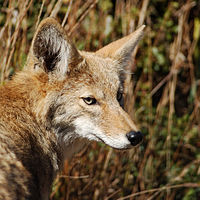Coyote/Project tools
Contents
Measuring from photographs
It is possible to measure from any image that includes an accurate scale bar in the shot. You could print the image and measure with a ruler. I pasted the image into a presentation slide in Open Office and used the line tool to draw lines where I wanted to measure. Line length shows up on the bottom of the slide as you draw. Regardless of measurement approach, there are just three needed parameters. I'll illustrate the procedure using the left side view of skull 12041209.
Easiest approach
Download ImageJ, a free open-source software package.
- Open an image and use the line tool in ImageJ to draw a line along a length of the ruler. I recommend using the full 15 cm to minimize calibration errors.
- Go under Analyze and select Set Scale.
- Edit Known Distance so that it equals the length of ruler you drew the line on above.
From that point forward, the length of any line you draw will be displayed on the menu bar. Most important: Remember to calibrate for each image.
Using ratios to measure
- X is the number of units on the scale bar you choose to work with. To illustrate, I'll use the entire length of the ruler from the zero marker to the 15 marker. In this example X = 15 cm.
- Y is the measured length of that number of units measured from the photograph. I measured the 15 cm section of ruler and it was 5.22 inches (the units for Y are arbitrary and mathematically cancel out)
- Z is the length you are interested in measuring from the image. I was interested in skull length so for me Z = 6.34 inches (measured in the same units used for Y)
Simple calculations
Calibration factor = Y/X. In my case Y/X = 5.22 inches / 15 cm = 0.348 inches per centimeter. So every 0.347 inches measured from this photograph is the same as 1 cm.
Actual measured length = Z / calibration factor. The total length of the skull = 6.34 / 0.348 = 18.22 This calculation is where the inches cancel out, so the skull length = 18.22 cm.
Measurements
There are many ways to measure from a photograph. A printout and a ruler is perfectly acceptable. We used the Presentation option in Open Office. Steps:
- Open the image of interest and copy it into Open Office
- Use the line-drawing tool (bottom left) to draw lines along the measurements of interest (see above).
- While drawing, the length of the line is displayed at the bottom of the screen as l =___.
What skull dimensions to measure
Length can be measured in at least two ways (Fig 1). The red line is the greatest length of the skull. We typically measure from the distal tip of the premaxillary bone at the front rather than from the teeth. This facilitates comparisons with toothless skulls. Condylobasal length (the blue line) tends to be slightly shorter than greatest length in coyotes. Both lengths are best measured from side views rather than top or bottom views. In the top and bottom views, the lengths are typically not parallel to the plane of the camera and will yield inaccurate results. Measurements from left or right views should be comparable.
Width is self explanatory and represented by the green line across the zygomatic arches (Fig 2). It should be the same whether measured from a top view or a bottom view.
Other parameters
There are many things that could be measured. For accuracy, it is important to measure between points that fall on a plane that is parallel to the photographic plane and in the same plane as the scale ruler. However, for comparative purposes, relative inaccuracies for structure in other planes should be consistent from skull to skull because we have consistently photographed the skulls from the same angle. So although you can't accurately measure the diameter of the eye socket from any of our photographs, you could compare eye sockets from Missouri specimens to eye sockets from Massachusetts specimens and determine if one set was larger than another.
Distances between teeth, lengths of post-canine tooth rows, and measurements from the palate are best made from the ventral view because the palate is approximately parallel to the photographic plane.


